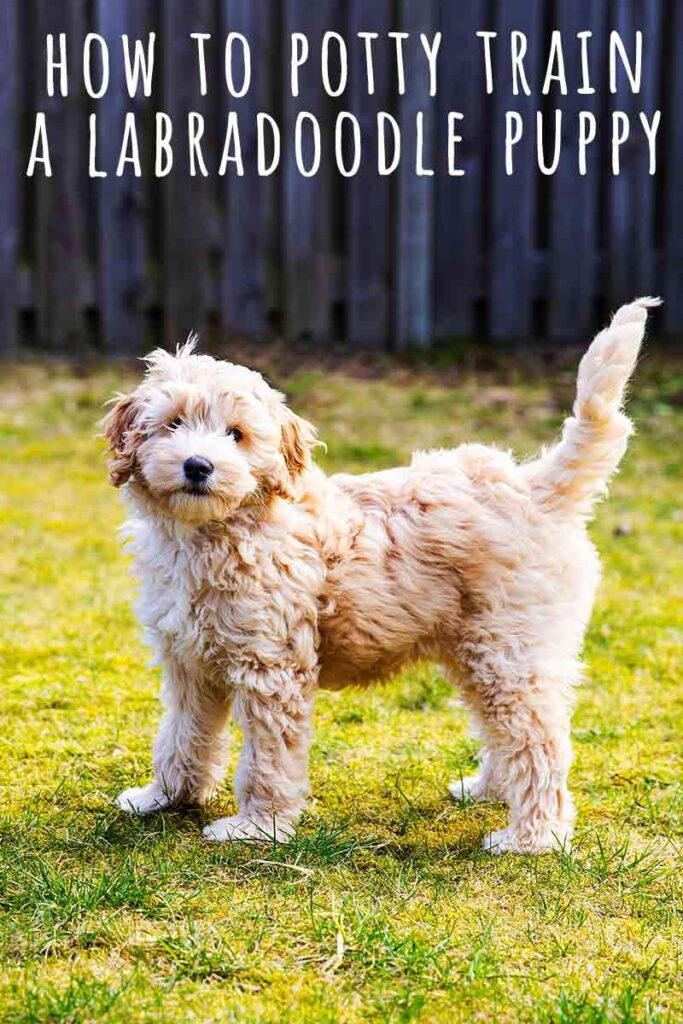To potty train a Labradoodle puppy successfully you will need a schedule to stick to, the right equipment, and some dedicated time. The schedule you follow will vary a little depending upon your own routine, and your puppy’s bladder. Some pups can wait an hour between pees from 8 weeks old. Most can’t. Many are closer to 20 minutes to begin with.
So let’s take a look at what we do to potty train our puppies, and how you can get off on the right paw.
How to Potty Train a Labradoodle Puppy
If this is your first time reading this guide, you may benefit from reading the entire thing. But, if you’re returning to refresh your learning, here are some quick links to help you navigate to the part you need.
- Labradoodle potty training do’s and don’ts
- Puppy pad training
- Crate training
- Combining the crate and puppy pads
- Schedules for potty training a Labradoodle puppy
Labradoodle Puppy Potty Training Do’s and Don’ts
How to potty train a Labradoodle puppy may be slightly different for each individual depending on the age of their puppy, their home layout, and their desired method. But, no matter what, there are some do’s and don’ts that will apply across the board. Here are some important points to keep in mind during those intense early days.
Do…
- Make a routine
- Stick to your routine
- Be realistic
- Adjust your expectations when necessary
- Clean up accidents immediately
- Watch your puppy
- Set your puppy up to win
Don’t…
- Punish accidents
- Rub their nose in it (literally!)
- Deprive your puppy of water during the day
- Leave your puppy alone if they are out of the crate or playpen
- Get ahead of yourself
- Stress
These do’s and don’ts are easy to remember, and will apply to every Labradoodle puppy owner, no matter what method of potty training they choose.

Ways to Potty Train a Labradoodle Puppy
There are two main schools of thought when it comes to potty training a puppy:
- Puppy pads
- Crate training
But there is also a happy medium, where you combine these when necessary.
Which Method is Best?
In reality, neither method is better than the other. But, one may be better for you and your lifestyle. So, don’t let anyone make you feel pressured into choosing one method over the other. When done correctly, both ways, and the happy medium, can create a well trained Labradoodle.
For some people, it’s important that their Doodle can go to the toilet outside from the start. Even if this means sacrificing a few good night’s sleep for those first weeks. But, for others, cleaning up puppy pads inside is no big deal! The end result will be the same – a Labradoodle that goes to the toilet in the right place.
Let’s take a look at both methods in a little more detail, and learn how to potty train a Labradoodle puppy successfully both ways.
Puppy Pad Potty Training
Potty training with puppy pads involves covering the floor of the area that your puppy has access to with pads. The floor you need to choose must be easy to clean for this method, like wooden or linoleum. So a kitchen is usually ideal.
Over time you reduce the area of the floor that has puppy pads on it, until it’s just one corner. Then, when your puppy is reliably toileting in this smaller area, you just pop a couple of pads outside the back door. Finally, you will remove them altogether.
Why Do I Have to Remove the Pads Gradually?
You must remove the pads gradually for the same reason that you must start off by covering your entire kitchen floor. To reduce the risk of your puppy having an accident on your floor itself!
At first, your puppy won’t know where it should or shouldn’t go to the toilet. To him, the floor might seem just as suitable as a puppy pad. So, covering the entire floor at first will remove the risk of any accidents on your floor.
Removing the pads gradually will help your puppy learn that the pads are the right place, rather than causing any confusion when they suddenly disappear.
Pros and Cons of This Method
The main benefit of this method is that you don’t need to monitor your puppy constantly, or live on a timer for the first few weeks. But the downside is that it takes longer to get your puppy going to the toilet outside. And in the meantime, you have a house that is periodically peed and pooped in.
It can also be more confusing for the puppy to transition to doing their business inside, to moving outside. Which can mean the occasional accident. That’s why, wherever possible, we recommend crate training instead.
Crate Training
Crate training is a great help to many puppy parents, because it helps your puppy learn to pee outside from the very start. A crate also gives your puppy their own cosy and safe space to stay in for short periods of time.
The crate must be big enough for the puppy to stand up and turn around in, but not much more. And it should be full of comfy, cosy bedding.
When gradually introduced to a crate, with lots of rewards and for very short periods to begin with, a puppy will love their soft bed very much. And because it is where they sleep, they will really not want to pee in there. As long as it is not too big.
This means it is a useful place to put your puppy if you want them to wait just a few short more minutes between pees. The rest of the time the pup is out and about in a wipe-clean room with you.
Avoiding Accidents
Watch them carefully when they’re out of their crate. If they squat or start sniffing around, take them outside and stay with them to see if they need the bathroom. You’ll periodically offer them the opportunity to pee or poop outdoors during the day, following the schedule further down the page.
If they have any accidents, clean them up with a pet safe spray straight away. If you don’t completely remove the accident, it increases the chance of your puppy going in the same place. But hopefully, your schedule and lots of close monitoring will mean that accidents are few and far between.
Using the Crate Safely
When used properly, a crate can make a great training tool. As long as it’s the right size, your puppy will avoid going to the toilet there, as it won’t want to spoil its sleeping area. However, if your crate is too large, your puppy will simply go to the toilet at one end and sleep at the other.
The benefit of the crate is that you can easily wash bedding and clean the crate tray if there are any accidents. But, this doesn’t mean that you can just shut your puppy in his or her crate all day to avoid any potty mistakes.
Labradoodle puppies need lots of mental stimulation, play, engagement, and exercise. Shutting them in their crate all day is cruel, and won’t help them to develop into healthy, happy adults. If you’re using a crate as a training tool, make sure your puppy gets plenty of breaks from it during the day.
An Alternative to the Crate
Puppies won’t like to pee in their crate, so it can be a great way of extending that period between potty breaks a little bit. But, another great way to do this is simply by picking your puppy up.
If they usually pee every 20 minutes, and you want to see if they will last 30 minutes, just pick them up after 20 minutes if they have already spent a lot of time in their crate today. Hold them for 5 or 10 minutes before taking them out for a pee. Your crate doesn’t need to be your only option.
And remember, you need to introduce the crate gradually at first, to ensure your puppy feels happy and safe inside. So, picking them up will help you a lot in those early days.
Combining Crates and Puppy Pads
The crate training puppy method requires getting up at 2am for at least a few days, as you will need to continue to offer regular potty breaks through the night. Many puppy parents find this understandably tough.
It also means that you can barely remove your attention from the puppy at all during the day for the first few weeks. But, puppy parents are often human parents too. And, you may need to pop out of the house for a few minutes a couple of times a day as a minimum.
A great way to deal with these situations is to set up your crate inside a puppy playpen. During the night and when you need to briefly pop out during the day, you leave the crate door open and line the puppy play pen with puppy pads. This means they can relieve themselves if they need to, without risking messing in their bed or on your floor.
Schedules for Potty Training a Labradoodle Puppy
To give your puppy the best chance of success when crate potty training, you need to give them lots of opportunities to use the bathroom outdoors. These timings are not set in stone, but are a good starting point for each stage.
8 – 9 Weeks Old Puppy Potty Schedule
- 2am: set your alarm and try to pre-empt your puppy waking
- 6am: pee break
- 7am: breakfast then pee break
- 9am: pee break
- 11am: lunch then pee break
- 1pm: pee break
- 3pm: tea then pee break
- 5pm: pee break
- 7pm: dinner then pee break
- 9pm: pee break
- 11pm: pee break
Remember to be flexible with these timings as you learn your puppy’s natural toilet rhythm. Some owners will find that they need to offer a pee break as often as every 20 minutes. Watch out for the behaviors we talked about above if you think your puppy needs a pee – particularly sniffing in one spot and squatting.
10 – 12 Weeks Old Puppy Potty Schedule
- 6am: pee break
- 7am: breakfast then pee break
- 9.30am: pee break
- 11am: lunch then pee break
- 1.30pm: pee break
- 3pm: tea then pee break
- 5.30pm: pee break
- 7pm: dinner then pee break
- 9.30pm: pee break
- 11pm: pee break
By this age, you may be able to get rid of that tiresome 2am pee break! Many puppies will start sleeping through the night. But, listen out for any telltale squeaks that they’re awake and need to go.
4 – 6 Months Old Puppy Potty Schedule
- 6am: pee break
- 7am: breakfast then pee break
- 10am: pee break
- 12noon: lunch then pee break
- 3pm: pee break
- 5pm: dinner then pee break
- 8pm: pee break
- 11pm: pee break
How to Potty Train a Labradoodle Puppy
To potty train your Labradoodle puppy you will need to dedicate a few weeks to keeping a really close eye on them. Give them lots of opportunities to pee outdoors, including after every meal or big drink from their water bowl.
Remove the water at night, but keep it somewhere they can get at it during the day. In those early weeks, they should spend most of their time with you in a room with wipe-clean floors, just in case!

